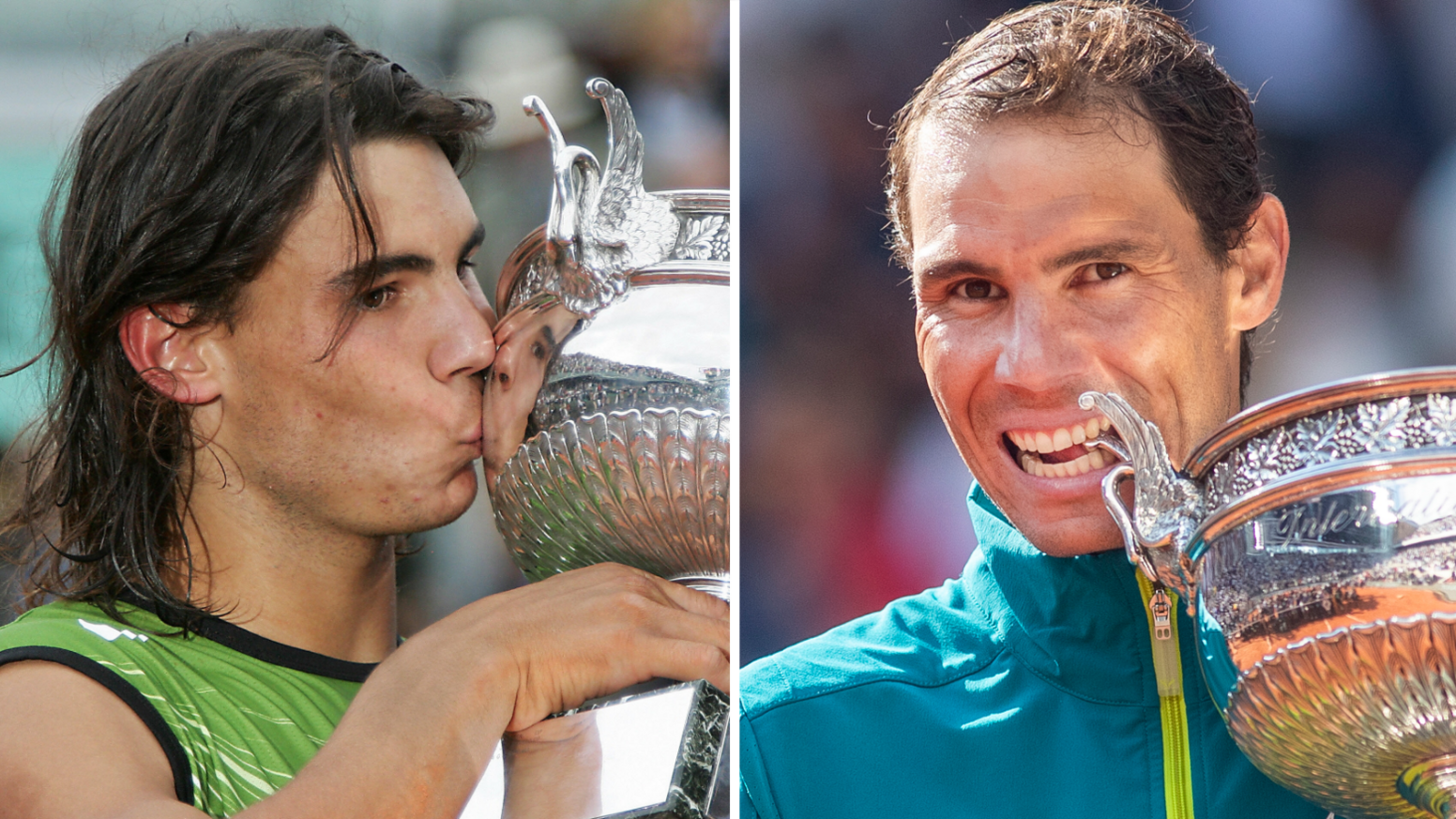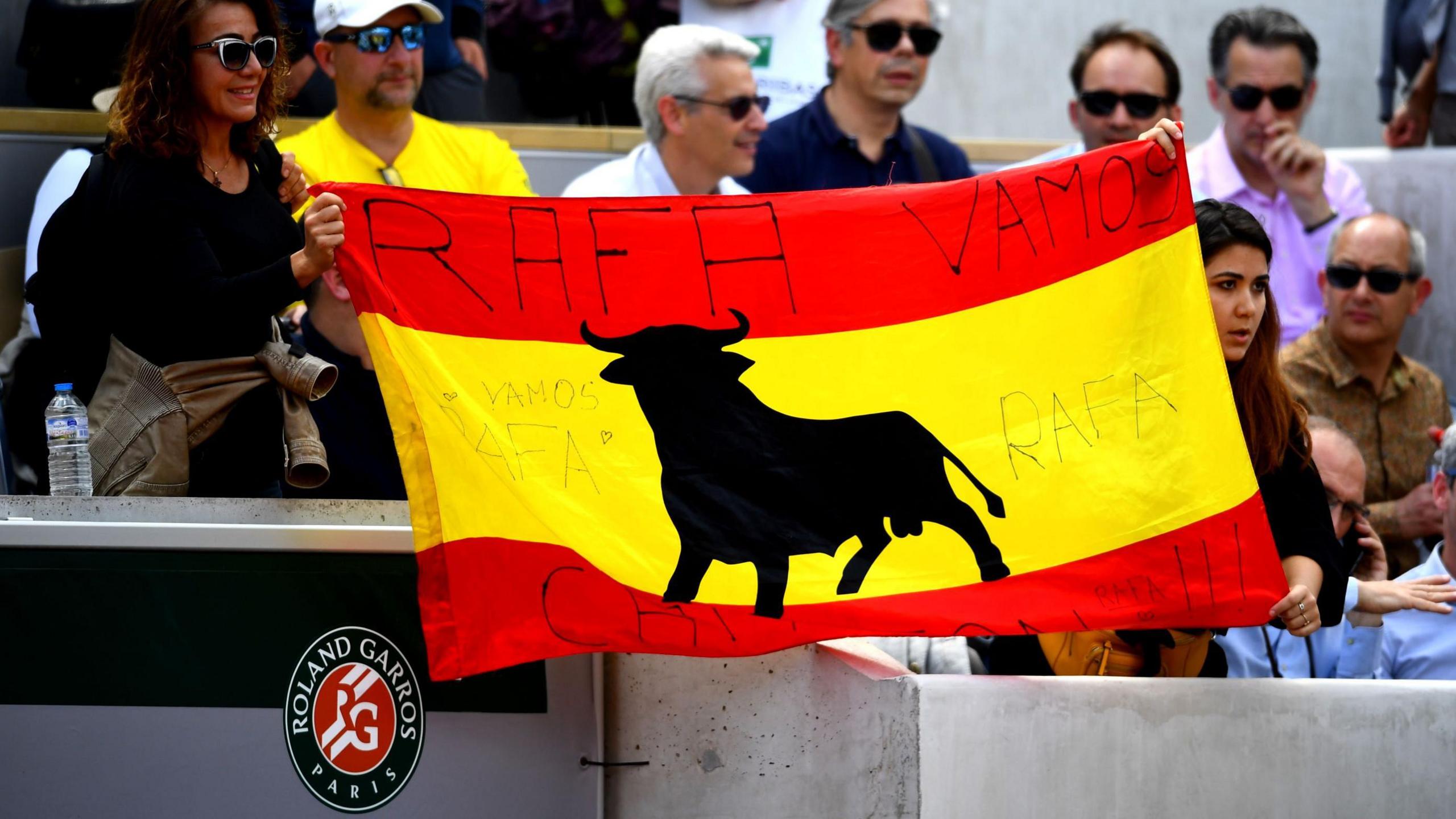'Nadal's success made Roland Garros feel like the Bernabeu'

Rafael Nadal won his first French Open title in 2005 and claimed his 14th in 2022
- Published
When you arrive through the gates at Roland Garros one of the first things that catches your eye is a sculpture depicting its finest champion.
The pose is unmistakeable.
Rafael Nadal, left arm across his chest, feet levitating above the court and mouth agape, has just walloped a trademark forehand winner.
The next fortnight will be the final time it will be seen in the flesh at the French Open.
Nadal, who turns 38 during the tournament, is set to play the clay-court Grand Slam for one last time before retiring, having won a record 14 men’s singles titles.
"The French Open is the most important tournament of my tennis career. All the things that I lived there, enjoyed there, stays in my heart forever," said Nadal, who faces German fourth seed Alexander Zverev in a tough first-round draw.
The 'unbelievable' numbers behind Nadal's success
No player in tennis history has been as synonymous with a tournament as Nadal has been with the French Open.
The Spanish left-hander’s dominance at Roland Garros is why he is known as the 'King of Clay'.
The facts and figures - supplied by OptaAce and the International Tennis Federation - clearly illustrate his dominance:
Nadal is the only player in history to win 14 singles titles at one Grand Slam tournament
Nadal has won 112 of his 115 matches there – the highest winning percentage of any singles player at a major
Nadal is the only player to win five successive titles at Roland Garros (2010-2014)
Nadal is the only man to win four Grand Slam titles without dropping a set (2008, 2010, 2017 and 2020)
Nadal has only ever lost to two men – Robin Soderling (2009 fourth round) and Novak Djokovic (2015 quarter-finals, 2021 semi-finals)
Five of Nadal’s victories in Paris are among the top 20 most dominant Grand Slam men's singles title runs by games dropped
Nadal won the first 16 of his 22 Grand Slams under the tutelage of his uncle Toni, who watched him hit a tennis ball for the first time aged three and coached him until 2017.
"When Rafael was young I tried to teach him how important it was to improve every day, every single match and every single tournament. We weren't thinking Roland Garros was more important than Wimbledon or the US Open," Toni Nadal told BBC Sport.
"I grew up watching Bjorn Borg, I could see how good Borg was on clay and saw him win Roland Garros six times.
"For me that was unbelievable - six times. Years later I saw my nephew win it 14 times. It is incredible what we have seen him do."
Why is Nadal so good on clay?
Nadal's main weapon is the vicious, lasso-style forehand that is immortalised in steel at Roland Garros.
That, combined with his sharp movement and supreme athleticism, is what has made him so great in Paris.
"He has the uncanny ability of being able to hit a lot of forehands and move very well on clay," Michael Chang, the American who won the 1989 title, told BBC Sport in 2018.
"He knows how to manipulate the angles and get people out of position.
"He is very aggressive, although patient when he needs to be, but if the shot is there he is going for it."
Clay slows the ball down more than grass, enabling Nadal to construct his points and tee up that famed forehand.
The hotter summer temperatures in mainland Europe - where the majority of the clay-court season takes place - also help Nadal generate more bounce.
It is notable that his successes at the Monte Carlo and Rome Masters tournaments outnumber those in Madrid, as the high altitude of the Spanish capital means the ball has less top spin and bounces lower.
"Spin is very important at Roland Garros," Toni Nadal said.
"Rafael moves his wrist very fast to get a lot of spin - we worked on that from a young age.
"To play flat is more difficult and Rafael has incredible feeling in his hands."
Why Roland Garros means so much to the Spanish

Lots of Spanish flags are seen in the stands during Nadal's matches at Roland Garros
Clay is the natural surface for Spanish players, with about 100,000 courts across the country - most small villages have them.
So it is not surprising that Nadal emerged as the latest in a long line of Spanish success - albeit far more sustained than his predecessors - at Roland Garros.
Nadal's 14 wins, plus triumphs for Sergi Bruguera (two), Carlos Moya, Albert Costa and Juan Carlos Ferrero, means the nation has accounted for 19 of the past 30 men's champions.
Carlos Alcaraz, the two-time major winner who is the Spanish heir apparent to Nadal, is expected to add to that in the coming years.
Wandering around Court Philippe Chatrier - particularly before Nadal played a French Open final - felt like being outside the Santiago Bernabeu in the build-up to a big Real Madrid match.
Spanish speakers can be heard everywhere, chattering about the prospect of seeing one of the nation's favourite sons creating more history.
Splashes of red and yellow are ubiquitous on flags, football kits and hats. Super-fans wear Nadal-branded 'raging bull' hats and t-shirts.
Ferrero, the 2001 champion, says it feels like a home from home.
"Roland Garros is the closest Grand Slam and the fact that it is held on clay makes it even closer to Spain," he said.
"The fact that Spanish players have won it a lot, and especially thanks to Nadal, [means] tennis fans relate Roland Garros with good moments for Spanish tennis."